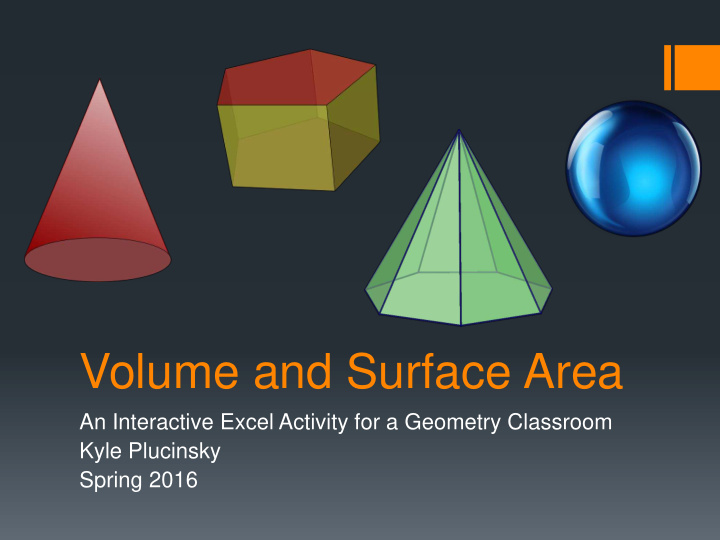



Volume and Surface Area An Interactive Excel Activity for a Geometry Classroom Kyle Plucinsky Spring 2016
Target Audience High School Geometry 9 th ,10 th , and 11 th Grade Students A or B Level Timeline: 1 day Prior Lessons: Introduction and Practice of Surface Area and Volume Formulas
Goals and Objectives SWBAT: Use Excel to calculate perimeters, areas, surface areas, and volumes of polygons and solids Check their homework and classwork with the Surface Area and Volume Calculator Describe the behavior of volumes and surface areas as dimensions increase constantly
NJCCCS HSG-GMD.A.3 Use volume and surface area formulas for cylinders, pyramids, cones, and spheres to solve problems. HSG-MG.A.1 Use geometric shapes, their measures, and their properties to describe objects (e.g., modeling a tree trunk or a human torso as a cylinder).
Activities Homework Review Students check their homework answer using the spreadsheet Castle Activity Students will find the surface area and volume of a castle made up of various solids
Spreadsheets Formulas Absolute Reference
Excel Features Graphs Conditional Formatting
More Features Excel’s Built -In Functions Concatenate Hyperlink
Evaluation Homework Review – self-evaluation Castle Activity – Formative Assessment Listening to student discussions Asking critical thinking questions Reviewing final answers to SA and V
Gardner’s Multiple Intelligences Logical-Mathematical – formulas on Excel Visual-Spatial – graphs showing the behavior of volumes and surface areas as heights, radii, etc change Intrapersonal – checking own understanding using spreadsheet Interpersonal – cooperative learning Bodily-Kinesthetic – moving around and measuring parts of castle
Brainy Bits Frontal Lobe Problem-solving skills, critical thinking Occipital Lobe Looking a graphs, solids making up the castle Parietal Lobe Processes sensory information Temporal Lobe Discussion with classmates
Citations Images http://drumminns.scoilnet.ie/blog/files/2012/01/2012-01-16-3D- Shape-Castle.jpg http://villagecenterchiropractic.com/wp- content/uploads/2015/07/lobes-of-brain.jpg https://education- 2025.wikispaces.com/file/view/wordle.jpg/278293886/554x298/w ordle.jpg Sources Gardner, H. (1983). Frames of Mind: The Theory of Multiple Intelligences . New York: Basic Books Sousa, D. (2011). How the Brain Learns (4 th ed.). Thousand Oaks, CA: Corwin Press
Recommend
More recommend